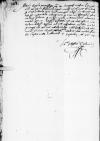1537-09-04⌊Heri1537-09-04⌋ vesperi, sciens mane hodie dominum ⌊Nicolaum Plotowski⌋ ⌊hinc⌋ puerum ad ⌊fratrem suum⌋ amandaturum, Dominationi Vestrae breves has adiunctas litterulas scripsi, pauloque post, iam nocte, rediit nuntius meus satis exspectatus cum hoc fasciculo ⌊⌋ novarumque rerum ex ⌊Cracovia⌋ colligato, ex quo in rem nostram plurima Dominatio Vestra intelliget, maxime autem, quae
cf. Adagia 1526 No. 980 Corpus sine pectore ⌊corpus illud sine pectorecf. Adagia 1526 No. 980 Corpus sine pectore ⌋, incitante
cf. Ecriture - caput sine lingua – – Aulus Gellius: Noctes Atticae l.3, c.18: Habet et Crocodillus caput sine lingua sed dentibus armatus ⌊capite crocodilino sine lingua sed dentibus armatocf. Ecriture - caput sine lingua – – Aulus Gellius: Noctes Atticae l.3, c.18: Habet et Crocodillus caput sine lingua sed dentibus armatus ⌋ apud ⌊reginalem maiestatem⌋ per suos egit[1]. Quod quidem corpus et hoc, quod in eo est hominis – non admodum multum – nihil aliud, quam cf. Adagia 1526 No. 1419 Lindii sacrum ⌊⌊Herculi Lyndio⌋ sacrificarecf. Adagia 1526 No. 1419 Lindii sacrum ⌋[2] novit. cf. Adagia 1540 No. 3977 Lucernam accendere possis ⌊Excandescat, ut lucernam etiam possit incenderecf. Adagia 1540 No. 3977 Lucernam accendere possis ⌋, cf. Adagia 1526 No. 1976 In fermento iacere ⌊iaceatque in fermentocf. Adagia 1526 No. 1976 In fermento iacere ⌋ totum – non assequetur amplius, quam is, qui cf. Adagia 1526 No. 379 Ab asino lanam ⌊in asino lanam quaererecf. Adagia 1526 No. 379 Ab asino lanam ⌋ aut cf. Adagia 1526 No. 378 Ex harena funiculum nectis ⌊ex harena funiculum necterecf. Adagia 1526 No. 378 Ex harena funiculum nectis ⌋ nititur. Idipsumque certius experietur, cum, ut spero, brevi ⌊cubicularius regius⌋[3] ad nos revertetur. Qua de re Dominationem Vestram boni esse animi iubeo. In me nihil ego desiderari patiar, quin immo et hoc addo, priusquam istorum duorum ardelionum[4] amentes conatus videre deberem perfici, me hoc loco potius neutiquam cessurum. Essetque mihi ea provisio et cautio, quo id, quod temere et insipienter conceperunt, reprimi et in favillas redigi posset. Quodque summe me firmat: cf. Rm 9.19 voluntati enim eius quis resistit; Est 13. 9-11 et non est qui possit ⌊Quid est quod Dei, cui nos commisimus, consilio et voluntati resistit?cf. Rm 9.19 voluntati enim eius quis resistit; Est 13. 9-11 et non est qui possit ⌋[5] Ex coniuncto fasciculo Dominatio Vestra habebit maiori ex parte, quae in ista bellica expeditione apud maiestatem regiam geruntur; quae velim esse auspicatiora, quam ea homines malevolentiae iniciati et devoti faciunt. Subvereor certe, ne quid gravius ex iis turbis huic sancto ⌊nostro principi⌋ exoriatur. cf. WALTHER, Proverbia No. 22416a Principii boni finis bonus ⌊Ut enim ponu<n>tur initia, sic solent sequi ceteracf. WALTHER, Proverbia No. 22416a Principii boni finis bonus ⌋. De iis ⌊reverendissimus dominus Gnesnensis⌋ neque item ⌊Plocensis nominatus Cracoviensis⌋ quicquam scripserunt. Neque res est, quae divulgari debeat, continebit itaque ea, quemadmodum et alia omnia sub singulari confisione scribo, apud se. Dominus Deus orandus est, quod velim etiam apud
ecclesiam vestram, vel communem nostram, fieri, ut ⌊regi nostro⌋ contra eius rebelles et hostes det felicem victoriam atque reditum, nihiloque secius hoc pro ⌊caesare⌋ contra ⌊Turcam⌋ et ⌊Gallum⌋ fieri censerem, cum totius ⌊Reipublicae Christianae⌋
salus ex hoc uno ⌊principe⌋ dependet. Incidimus in haec tempora, quibus nesciosi umquam rebus Christianis fuerint periculosiora, nedum duriora, et haec ab uno homine sic infesta et perturbata redduntur, qui, nisi vere gallus ⌊Cybelles⌋ fiat, quod brevi futurum existimo[6], cf. Rupertus Tuitiensis col. 1067 Reges et principes primo ad se conuertet ac deinde per illos persecutionem sub omni coelo excitabit super omnes populos Christum confitentes ⌊longe ⌊orbi Christiano⌋ graviora mala excitabit etc.cf. Rupertus Tuitiensis col. 1067 Reges et principes primo ad se conuertet ac deinde per illos persecutionem sub omni coelo excitabit super omnes populos Christum confitentes ⌋
 BCz, 244, p. 222
⌊Maiestatem regiam⌋ processisse iam ex ⌊Leopoli⌋ versus ⌊Camyenecz⌋ Dominatio hidden by binding⌈[Dominatio]Dominatio hidden by binding⌉ Vestra ex iis in fasciculo leget. Unde non obscure coniecturam capio hidden by binding⌈[io]io hidden by binding⌉, quod ⌊cubicularius⌋, qui hinc novissime abiit, in
itinere alicubi ⌊serenissimam maiestatem hidden by binding⌈[erenissimam maiestatem]erenissimam maiestatem hidden by binding⌉ eius⌋ sit assecutus. Ideoque reor, quod vix ante praescriptum electioni diem hidden by binding⌈[em]em hidden by binding⌉ redire poterit. Quod si haec mora intervenerit, necesse erit, quemad hidden by binding⌈[emad]emad hidden by binding⌉modum per ⌊venerabile capitulum⌋ constitutum
est, ut dies iste in aliquot alios hidden by binding⌈[ios]ios hidden by binding⌉ extendatur. Quam primum ad me appulerit,
non diu hic tardabo, sed hidden by binding⌈[sed]sed hidden by binding⌉, quicquid ille ad me attulerit, Dominatio Vestra habebit, ut alia omnia, mecum commune. Quam felicissime valere animo minime fucato cupio.
BCz, 244, p. 222
⌊Maiestatem regiam⌋ processisse iam ex ⌊Leopoli⌋ versus ⌊Camyenecz⌋ Dominatio hidden by binding⌈[Dominatio]Dominatio hidden by binding⌉ Vestra ex iis in fasciculo leget. Unde non obscure coniecturam capio hidden by binding⌈[io]io hidden by binding⌉, quod ⌊cubicularius⌋, qui hinc novissime abiit, in
itinere alicubi ⌊serenissimam maiestatem hidden by binding⌈[erenissimam maiestatem]erenissimam maiestatem hidden by binding⌉ eius⌋ sit assecutus. Ideoque reor, quod vix ante praescriptum electioni diem hidden by binding⌈[em]em hidden by binding⌉ redire poterit. Quod si haec mora intervenerit, necesse erit, quemad hidden by binding⌈[emad]emad hidden by binding⌉modum per ⌊venerabile capitulum⌋ constitutum
est, ut dies iste in aliquot alios hidden by binding⌈[ios]ios hidden by binding⌉ extendatur. Quam primum ad me appulerit,
non diu hic tardabo, sed hidden by binding⌈[sed]sed hidden by binding⌉, quicquid ille ad me attulerit, Dominatio Vestra habebit, ut alia omnia, mecum commune. Quam felicissime valere animo minime fucato cupio.
 BCz, 244, p. 222
BCz, 244, p. 222


